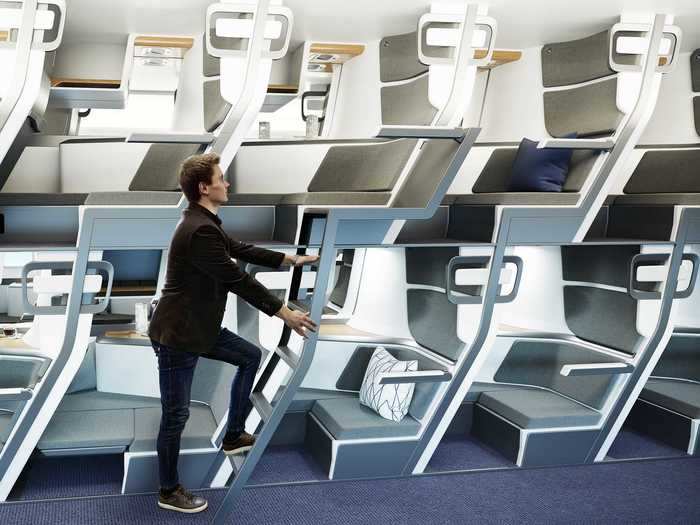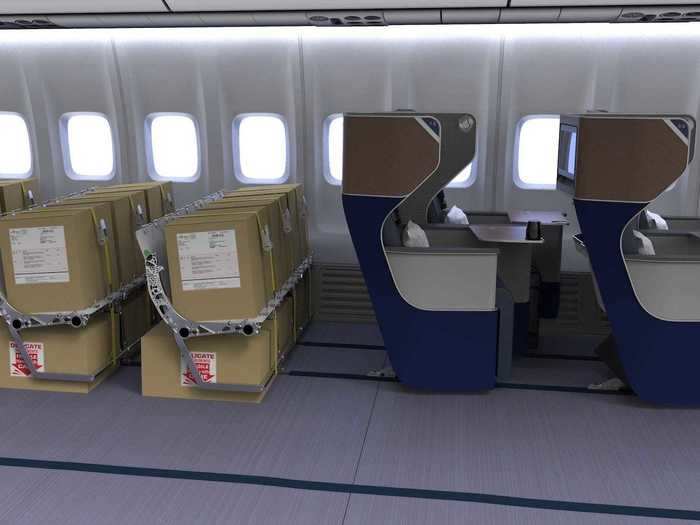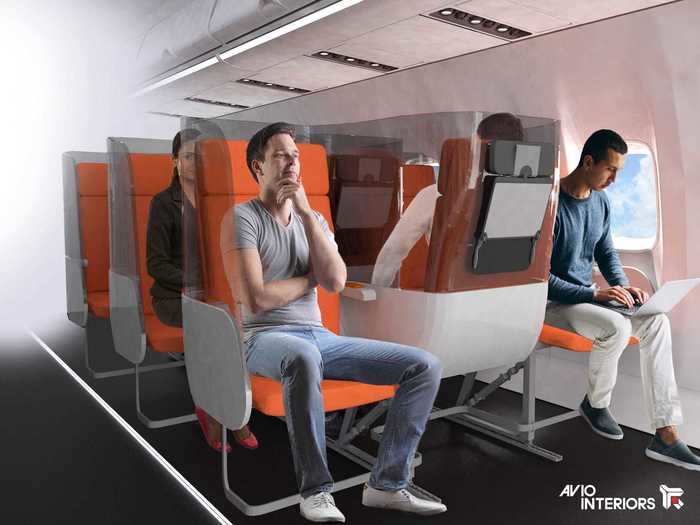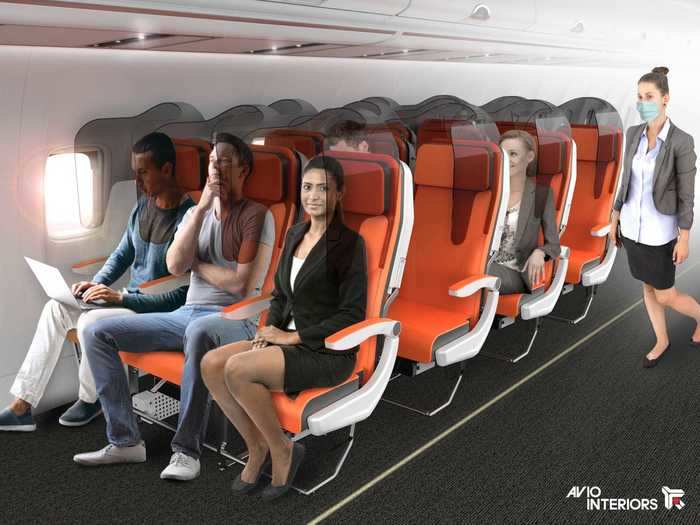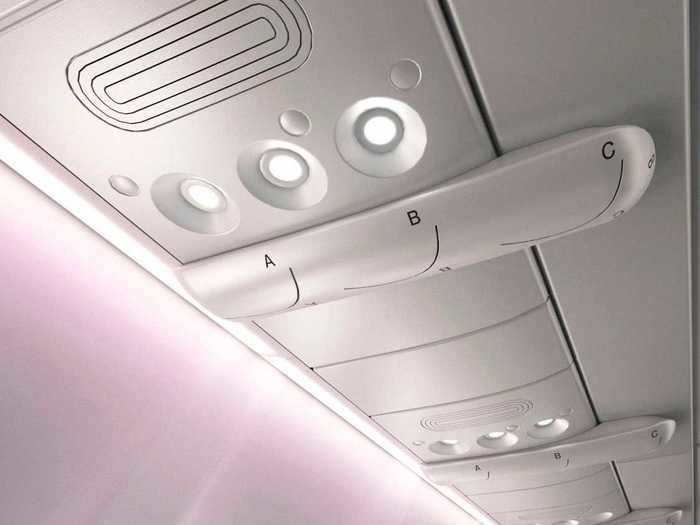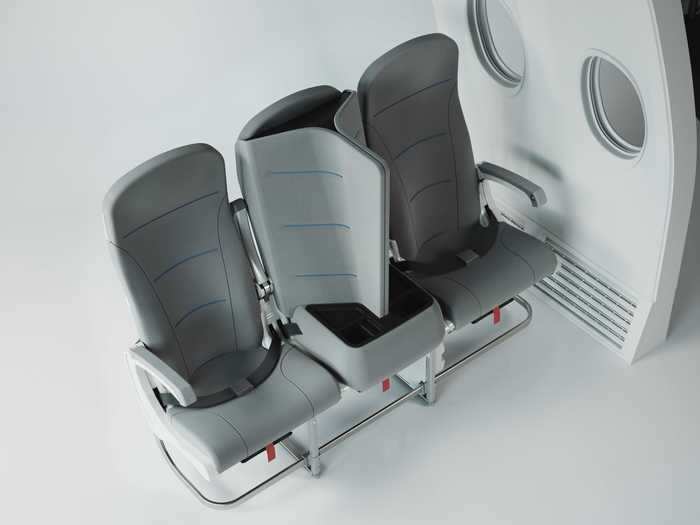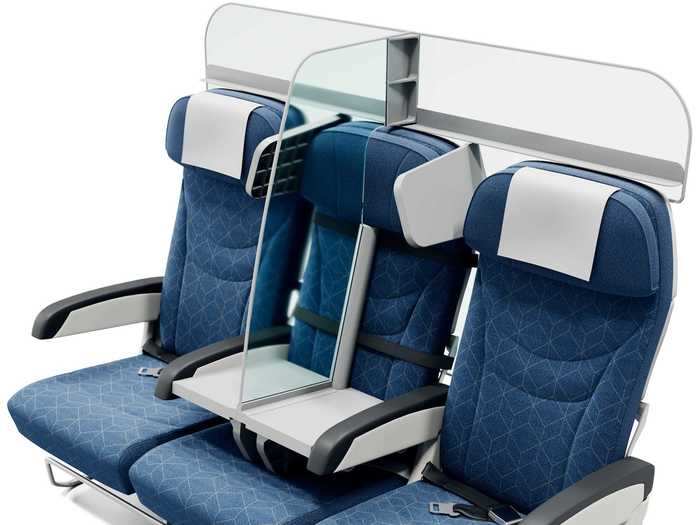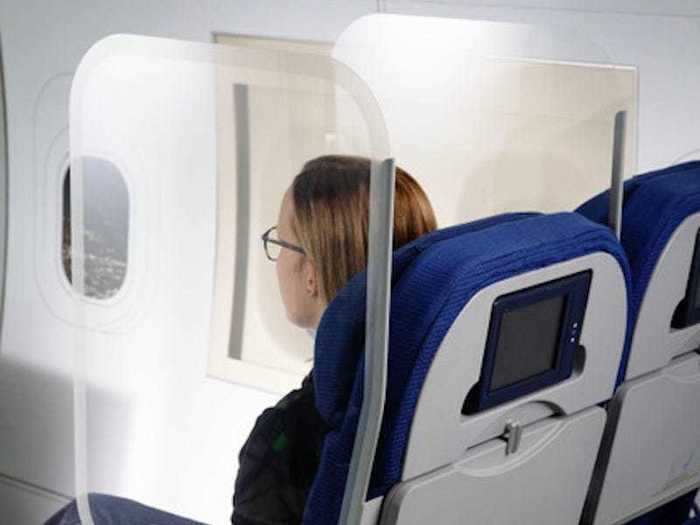A reversible middle seat means airlines can maintain their passenger capacity.Avio Interiors - The coronavirus has caused a significant drop in air travel.
- Despite masks being mandatory on most major airlines, and sanitation and hygiene practices being stepped up, designers have come up with their own ways to ensure safer air travel.
- One 3D-printed product from design firm Teague would attach to the vents above seats to push passengers' breath down, described on its company's website as "an invisible germ isolation unit."
- Another design firm, Haeco, sees a future in which passengers share the airplane cabin with cargo, allowing for more space between people.
The coronavirus pandemic has already changed air travel. Wearing masks is now required by most major airlines, and no one will blink an eye should you frantically sanitize every nearby surface.
Some travel experts predict that airlines will hire in-flight janitors and create a social distance-friendly new class.
Design firms are also getting creative when it comes to travel, and are coming up with innovative concepts for designs that could change air travel significantly.
Double-decker plane seats could allow economy passengers to lie flat and socially distance.
This design allows for more privacy, without cutting passenger numbers.
Zephyr Aerospace
Designer Jeffrey O'Neill created the Zephyr Seat, a double-decker-like design that would allow passengers in economy class to lie flat, while also maintaining social distancing.
Kind of like a bunk bed, two people would share a row, but one on top of the other, meaning more privacy and space without airlines having to compromise on passenger numbers.
According to CNN, O'Neill will have to test the seat's safety next, which could take up to three years. It is currently crowdfunded and has received over 424% of its original goal at the time of writing.
Design firm Haeco sees a future in which passengers share the airplane cabin with cargo, allowing for more social distance.
The demand for cargo capacity has increased during the pandemic.
Haeco Aero
Aircraft engineering company Haeco came up with a way to space people apart by limiting the number of travelers on planes, but without necessarily costing airlines money in lost ticket revenue.
It proposes mixing passengers and cargo in the cabin by creating devices that allow for safe package stowage between rows of passengers. And as DW news points out, "demand for cargo capacity is bigger than for seats."
According to a press release, Haeco plans on "using packages to distance passengers and maintain proper weight and balance requirements."
Different designs would be able to hold a different amount of weight and package sizes, and can be delivered within four to six weeks, according to the press release.
The Janus design from Avio Interiors reverses the middle seat in each row of three and includes transparent dividers that shield passengers from one another.
A reversible middle seat means airlines can maintain their passenger capacity.
Avio Interiors
Italian design firm Avio Interiors has created renderings that posit a solution for keeping flights full while minimizing passengers' exposure to one another. Its concept would reverse the middle seat in each row of three and include transparent dividers to shield passengers from one another.
The Glassafe would act like a transparent cheese bell of sorts, draped over existing seats to cocoon passengers and shield them from others.
These shields would minimize the probability of contamination via aerosols.
Avio Interiors
The Glassafe is another design by Avio Interiors. This concept, however, uses existing infrastructure, as it can simply be added on to existing seats.
According to a press release, it allows planes to maintain full capacity while isolating passengers from one another, minimizing the contact between them, and reducing the probability of contamination via aerosols.
The 3D-printed AirShield would attach to the vents above seats and push passengers' breath down to slow the spread of viruses.
The company describes it on its website as "an invisible germ isolation unit."
Teague
Design company Teague introduced AirShield, which they describe in a press release as "the world's first germ isolation system that uses controlled airflow to restrict the spread of a virus."
The company's press release says the 3D-printed device would be positioned on top of the existing vents above seats to contain droplets from coughs or sneezes within that passengers' own space, thus slowing the spread of viruses.
According to the same press release, the system is currently being developed for a planned release later this year.
This seat design similarly separates passengers from one another, but also blocks off the middle seat for more distance between passengers.
The Interspace Lite seats were originally designed to make sleeping more comfortable.
Universal Movement
Aerospace manufacturer Safran and transportation technology company Universal Movement collaborated on Interspace Lite, a concept for a new seat design with a curved barrier to separate those sitting in the aisle from those in the window seat, while blocking off the middle seat.
Like many of the other designs, this is a temporary kit that can be added to existing seats, and removed post-pandemic. But unlike some of the other shields, this one isn't transparent, making for a more private flying experience.
The seat design was originally released in 2019 to make sleeping more comfortable, CNN reports, but was redesigned during the pandemic to enable social distancing and minimize the spread of the coronavirus.
According to Safran's website, Interspace Lite should be available this summer.
This removable shield for middle seats is designed to protect passengers from aerosols from both behind and neighboring seats, and helps maintain social distance.
Blocking the middle seat helps maintain social distance.
Earth Bay
Florian Barjot, an aeronautical engineer at Earth Bay, also designed a product that could be used on existing infrastructure, rather than redesign plane interiors entirely.
PlanBay is a concept for a removable shield for middle seats meant to protect passengers from both behind and neighboring seats, while also maintaining social distance by blocking middle seats.
AeroGlass is a screen that can be fitted between seats, protecting passengers from airborne particles much as face shields do.
AeroGlass is made with extra thin and strong laminated glass.
Aviation Glass & Technology
Dutch company Aviation Glass said in a press release that its AeroGlass screen "makes it possible for large groups to fly in a post-COVID-19 world."
Made of extra thin and strong laminated glass designed specifically for aircraft interiors, these screens can be fitted onto existing seats, protecting passengers from one another and minimizing contact, while maintaining airlines' ability to keep flights full.
According to the press release, AeroGlass meets the strict aviation industry requirements and the safety regulations of the European Aviation Safety Agency (EASA).

